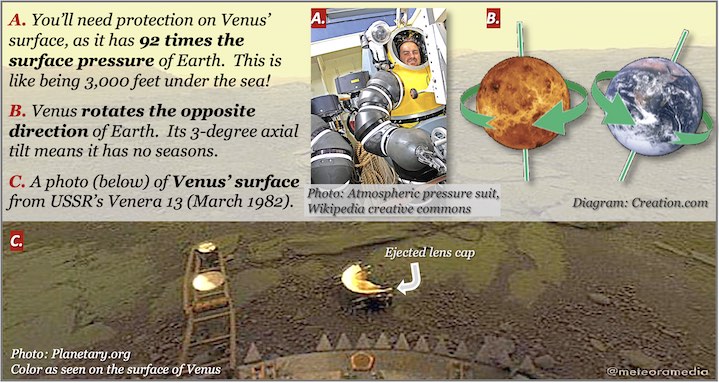Our next stop through the solar system is Venus, Earth’s alleged twin. Evolution theorizes that Venus should be similar to Earth. In some ways it is: Venus is 95% of the Earth’s diameter and has 90% of our gravitational force. The differences, though, are stark. For starters, it has no seasons, moon, oxygen or water. Let’s address its other differences both to Earth and evolution’s theory in greater detail.
Heavy atmosphere. Venus has a runaway greenhouse effect, something Earth can never have. Our planet has a light atmosphere of non-greenhouse gasses like nitrogen and oxygen, while Venus has a thick atmosphere of carbon dioxide which produces 900 degree F. temps, day or night. High speed winds push swirling clouds of strong sulfuric acid all over the planet. Venus’ heavy atmosphere creates a crushing 92 atmospheres of surface pressure. This is like diving 3,000’ below the ocean surface. These harsh conditions destroyed over half of the former USSR’s unmanned landing craft to Venus before Venera 9 and 13 were able to successfully send images back home (see photo).
Spins backward. Evolution’s nebular hypothesis says as the disc of spinning gas called the nebula spirals in, all resulting planets rotate the same direction due to a law in physics called the “conservation of angular momentum”. Venus rotates in the opposite direction of Earth and 7 other planets. It also turns super slow (one rotation per year). Evolutionists first tried to claim the planet has a bulge upon which Earth’s tidal forces acted, but Venus is the most spherically-shaped planet. I think God did this just to confound future explorers.
Geologically active. Evolutionary models say Venus should be geologically dead due to a thick crust without any tectonic plates; but in 1990, Magellan’s radar images showed crustal blocks knocking into each other like ocean ice blocks. It also has more volcanos than Earth. This means Venus is geologically active and looks young. Magellan’s radar mapped out 36,000’ high mountains, 5,600-mile long rift valleys, as well as canyons, volcanos, lava flows, craters and plains.
Fresh craters. The planet has 935 uniformly distributed craters, with only 15% showing some signs of erosion. Evolution says it should have many weathered and battered craters, but it doesn’t; so, they say it was totally resurfaced 500 million years ago when its core was hot and active, because their cratering model (which is wrong) demands it.
Missing magnetics. Venus has no detectable magnetic field, even though Mercury (which is 2-½ times smaller) does. Magnetic fields decay faster with smaller planets, so this is a big anomaly for evolution.
Bottom line. Evolution says Venus should be similar to Earth, but it isn’t. Venus has no moon, it’s crust is different, and it doesn’t have a magnetic field. It should rotate the same direction as Earth, but it doesn’t. It should be old, but its surface appears young and fresh showing little erosion. It should be geologically dead, but it isn’t.
Instead of being Earth’s twin sister, it looks more like hell. Venus’ surface has sulfuric acid winds, bone-crushing surface pressure and plenty of lava flows. It has no water. It’s unbearably hot everywhere at all time, even hotter than Texas. It definitely was not made to be inhabited. That’s reserved for Earth, as it is written: For thus saith the LORD that created the heavens; God Himself that formed the earth and made it; He hath established it, He created it not in vain, He formed it to be inhabited: I am the LORD; and there is none else.
Sources of info: Dr. Jonathan Sarfati, Venus: Cauldron of Fire, Creation.com, June 2001; and Dr. Jason Lisle, Worlds of Creation: Venus, Biblical Science Institute, April 2020. Photo: Ted Stryk, Every Picture from Venus Surface, Ever, The Planetary Society, accessed 6/29/2023.
Like this? Consider sharing it to Facebook by clicking the linked icon below.
